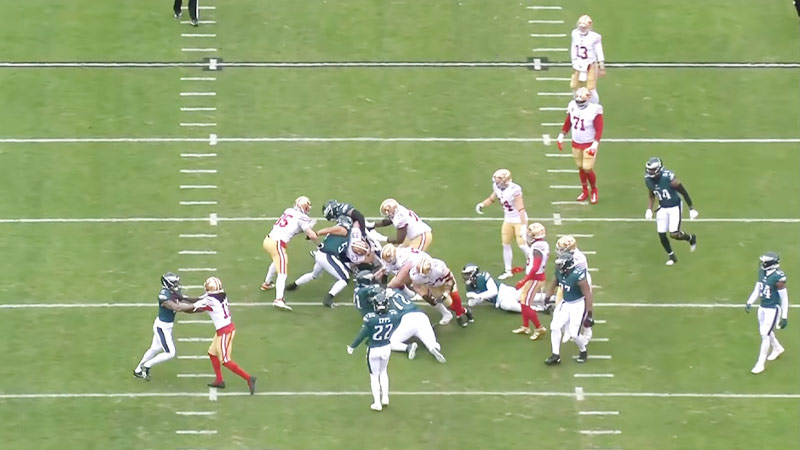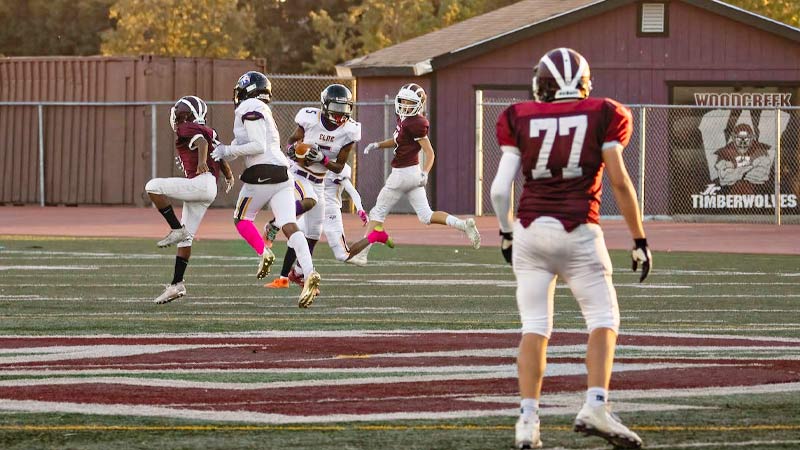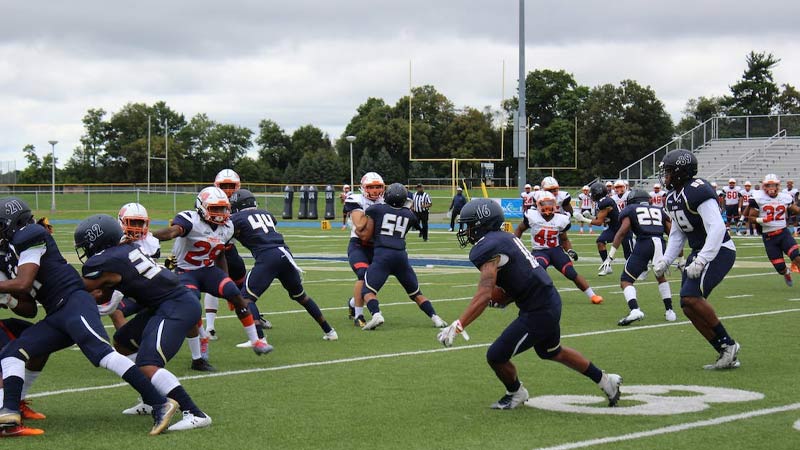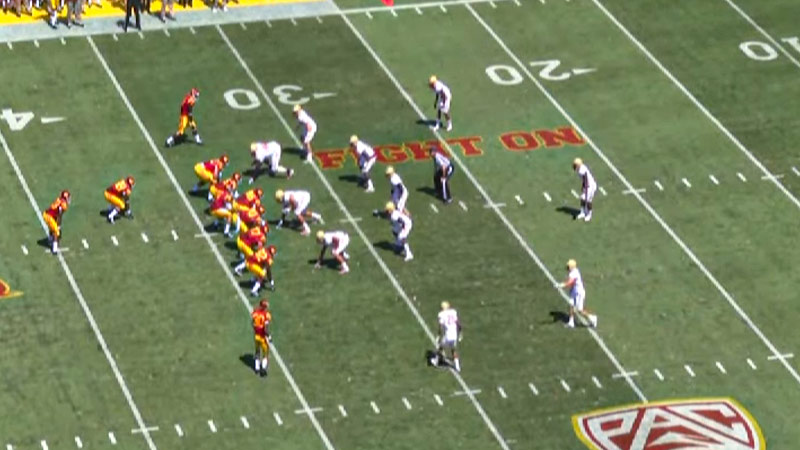In the ever-evolving world of American football, defensive coordinators are constantly on the lookout for game-changing strategies to halt the opposing offenses in their tracks.
Among the numerous defensive formations, the 3-4 Front Defense has emerged as a formidable and versatile scheme that has left offenses puzzled and quarterbacks scrambling.
With its unique alignment and dynamic play-calling options, the 3-4 Front Defense has become a go-to choice for many teams aiming to gain the upper hand on the gridiron. In this blog post, we delve into the intricacies of the
Football 3-4 Front Defense, explores its key concepts, responsibilities, and advantages to equip both fans and aspiring coaches with an in-depth understanding of this dominant defensive strategy. Stay focused.
What is Football 3-4 Front Defense
The 3-4 Front Defense is a defensive formation in American football that involves three defensive linemen and four linebackers as its primary alignment.
In this scheme, the linemen play over the offensive linemen to control gaps, while the linebackers have greater flexibility to support both run and pass defense.
The 3-4 Front Defense is known for its versatility, as it allows for various blitz packages and coverages, making it challenging for the offense to predict the defenders’ actions.
This formation is often used to stop the run, apply pressure on the quarterback, and defend against short and intermediate passing routes. It requires versatile linebackers who can both rush the passer and drop into pass coverage effectively.
Responsibilities of Football 3-4 Front Defense

In a Football 3-4 Front Defense, each position has specific responsibilities that contribute to the overall effectiveness of the defensive scheme:
Defensive Linemen (3 players)
Two Defensive Ends
Their primary responsibility is to set the edge, maintain containment against outside runs, and apply pressure on the quarterback during passing plays.
Nose Tackle
Lines up directly over the center and is tasked with occupying multiple offensive linemen, clogging running lanes, and disrupting the interior of the offensive line.
Linebackers (4 players)
Two Inside Linebackers
They are responsible for filling gaps in the middle of the field, stopping the run, and helping in short-pass coverage.
Two Outside Linebackers
Often referred to as “edge rushers,” their main tasks are to apply pressure on the quarterback, contain outside runs, and sometimes drop into coverage.
Defensive Backs (4 players)
Cornerbacks
Responsible for covering the wide receivers, preventing them from catching passes, and defending against deep throws.
Safeties
Provide deep coverage, help defend against long passes, and offer additional support against the run.
The 3-4 Front Defense is designed to confuse the offense with various blitz packages, stunts, and coverage disguises.
Practice the Strategies of 3-4 front Defense

Practicing the strategies of the 3-4 Front Defense requires a well-organized and structured approach. Here are some key steps and drills that can help players and coaches effectively practice and implement the 3-4 Front Defense:
Teach the Basics
Start by ensuring that all players understand their specific roles and responsibilities within the 3-4 Front Defense. This includes understanding gap assignments, coverage responsibilities, and proper technique for each position.
Individual Drills
Conduct position-specific drills to improve the skills and techniques of each player. For example:
- Defensive Linemen: Work on hand placement, shedding blocks, and maintaining gap integrity.
- Linebackers: Practice reading the offensive line, diagnosing plays, and perfecting tackling techniques.
- Defensive Backs: Focus on footwork, backpedaling, and coverage techniques.
Group Drills
Incorporate group drills that involve multiple players working together to execute the defense. This includes practicing stunts, blitzes, and gap exchanges between the defensive linemen and linebackers.
Team Drills
Implement full-team drills to simulate game situations and improve communication and coordination among all defensive players. Use scrimmage scenarios to work on both run defense and pass coverage.
Film Study
Analyze game footage to identify areas of improvement and reinforce proper execution of the 3-4 Front Defense. Study opponents to understand their tendencies and strategize accordingly.
Simulate Game Situations
Set up situational drills to practice responding to specific game scenarios, such as 3rd-and-long, goal-line defense, two-minute drills, etc.
Communication
Emphasize effective communication among players on the field. This includes calling out assignments, adjusting, and identifying potential threats.
Scout Team
Utilize the scout team to simulate the opposing offense’s plays and formations during practice. This allows the defense to practice their reactions to different offensive strategies.
Conditioning
A 3-4 Front Defense requires disciplined and physically fit players. Incorporate conditioning drills to ensure the players are in top shape to maintain their performance throughout the game.
Evaluation and Feedback
Regularly assess individual and team performance during practice sessions. Provide constructive feedback to players to help them improve their skills and understanding of the defensive scheme.
Advantages of 3-4 Front Defense

The 3-4 Front Defense offers several advantages that make it a popular and effective defensive scheme in American football:
Versatility
The 3-4 Front Defense is highly adaptable to various offensive formations and strategies. It allows for a wide range of blitz packages, stunts, and coverage disguises, making it challenging for the offense to predict the defenders’ actions.
Stopping the Run
With three down linemen and four linebackers, the 3-4 Front Defense provides more players closer to the line of scrimmage. This setup enables better run-stopping capabilities, as there are more defenders available to fill gaps and clog running lanes.
Pass Rushing
The scheme allows for multiple options to apply pressure on the quarterback. The outside linebackers, known as edge rushers, have the freedom to blitz from various angles, creating havoc in the backfield and increasing the likelihood of sacks and quarterback disruptions.
Coverage Flexibility
The 3-4 Front Defense offers greater coverage flexibility due to the presence of four linebackers. These linebackers can drop into pass coverage, helping to defend against short and intermediate passes, while the defensive backs can focus on deeper pass coverage.
Disguising Intentions
The alignment of the 3-4 Front Defense can make it difficult for the offense to identify which defenders will rush the passer and which will drop into coverage. This element of surprise can lead to confusion and mistakes by the opposing offense.
Confusing Offensive Line
The defensive linemen in the 3-4 Front Defense often engage in gap control and gap exchange, creating confusion for the offensive line. This can disrupt blocking assignments and create opportunities for defenders to penetrate into the backfield.
Linebacker Versatility
The scheme relies heavily on versatile linebackers who can excel in both pass rushing and pass coverage. Having athletic and skilled linebackers allows the defense to be more unpredictable and dynamic in its play-calling.
Personnel Flexibility
The 3-4 Front Defense allows for greater flexibility in personnel management. It can accommodate players with different skill sets, making it easier for coaches to adjust the defense based on the strengths and weaknesses of their roster.
Time of Possession Control
By effectively stopping the run and creating turnovers through aggressive pass rush and coverage, the 3-4 Front Defense can help control the time of possession, giving the offense more opportunities to score.
Disadvantages of 3-4 Front Defense

While the 3-4 Front Defense has several advantages, it also comes with certain disadvantages that coaches and teams need to consider:
Vulnerability to Inside Runs
With only three down linemen, the 3-4 Front Defense can be susceptible to powerful inside running plays. The absence of an extra defensive lineman on the line of scrimmage may create bigger gaps for running backs to exploit.
Less Immediate Pass Rush
Compared to a 4-3 defense with four down linemen, the 3-4 Front Defense may have less immediate pass rush since it relies on outside linebackers as primary edge rushers. Depending on the talent and skill of the linebackers, it could take longer for pressure on the quarterback to develop.
Linebacker Depth Required
The success of the 3-4 Front Defense relies heavily on the linebackers’ versatility and ability to both rush the passer and drop into coverage. Finding and maintaining depth at the linebacker position can be challenging, especially when dealing with injuries or player turnover.
Blitzing Risks
The scheme’s emphasis on creative blitz packages can leave the defense vulnerable to big plays if the blitz is picked up or if the offense anticipates it. A well-timed and well-executed screen pass or quick throw can exploit the openings left behind by blitzing linebackers.
Personnel Suitability
Implementing the 3-4 Front Defense requires specific personnel with the right skill sets for the defensive linemen and linebackers. If the roster lacks the right players or the personnel changes, it may be challenging to maintain the defense’s effectiveness.
Gap Control Challenges
Maintaining gap discipline is crucial in the 3-4 Front Defense, and any breakdown in assignment or missed tackle can result in significant gains for the offense.
Less Coverage Depth
While the 3-4 Front Defense offers flexibility in coverage, it may have fewer players in deep coverage compared to traditional 4-3 defenses, leaving the secondary vulnerable to deep passing plays.
Transitioning Difficulties
If a team decides to switch from a different defensive scheme to the 3-4 Front Defense, it can be a challenging transition. Players and coaches need time to adjust and master the new system effectively.
FAQs
What is the Football 3-4 Front Defense?
This defensive formation involves three defensive linemen and four linebackers as its primary alignment. The scheme is known for its versatility, allowing various blitz packages and coverage disguises, making it challenging for the offense to predict defenders’ actions.
What are the responsibilities of each position in the 3-4 Front Defense?
- Defensive Linemen
Two defensive ends set the edge and apply pressure, while the nose tackle occupies offensive linemen and disrupts interior plays.
- Linebackers
Two inside linebackers fill gaps and support run defense, while two outside linebackers excel at pass rushing and contain outside runs.
What advantages does the 3-4 Front Defense offer?
The 3-4 Front Defense provides versatility, run-stopping ability, effective pass rushing, coverage flexibility, and the ability to confuse the offensive line and disguise intentions.
What are the disadvantages of using the 3-4 Front Defense?
Vulnerability to inside runs, potential challenges in immediate pass rush, required linebacker depth, blitzing risks, and specific personnel suitability are among the disadvantages.
How can teams practice and implement the 3-4 Front Defense effectively?
Teams can practice the defense by teaching the basics, conducting individual and group drills, simulating game situations, studying game footage, using the scout team, and emphasizing communication and conditioning.
Wrapping Up
The Football 3-4 Front Defense has revolutionized the defensive game, providing coaches and players with a powerful and adaptable strategy to thwart offensive advances.
Its unique blend of pressure and coverage options, combined with the versatility of its linebackers, makes it a formidable force on the field.
The responsibilities, advantages, and disadvantages of the 3-4 Front Defense equip teams with the knowledge to elevate their defensive prowess and create a dominant presence on the gridiron.
As the sport continues to evolve, the 3-4 Front Defense stands as a testament to the ongoing quest for innovative defensive tactics in the pursuit of victory. Thank you for your support.







